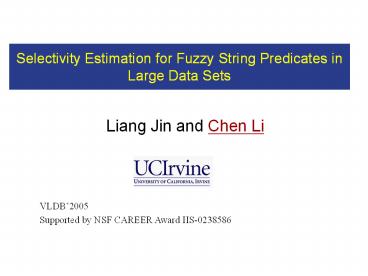Liang Jin and Chen Li - PowerPoint PPT Presentation
1 / 32
Title:
Liang Jin and Chen Li
Description:
Title: Slides 03 Subject: ICS214B: Transaction Processing and Distributed Data Management Author: Chen Li Last modified by: Chen Li Created Date: 8/28/1995 11:58:10 AM – PowerPoint PPT presentation
Number of Views:92
Avg rating:3.0/5.0
Title: Liang Jin and Chen Li
1
Selectivity Estimation for Fuzzy String
Predicates in Large Data Sets
- Liang Jin and Chen Li
VLDB2005 Supported by NSF CAREER Award
IIS-0238586
2
Example a movie database
Find movies starred Schwarrzenger?
Find movies with a star similar to
Schwarrzenger.
Star Title Year Genre
Keanu Reeves The Matrix 1999 Sci-Fi
Samuel Jackson Star Wars Episode III - Revenge of the Sith 2005 Sci-Fi
Schwarzenegger The Terminator 1984 Sci-Fi
Samuel Jackson Goodfellas 1990 Drama
3
Queries with Fuzzy String Predicates
- Stars name similar to Schwarrzenger
- Employees SSN similar to 430-87-7294
- Customers telephone number similar to 412-0964
- Similar to
- a domain-specific function
- returns a similarity value between two strings
- Example edit distance
- Ed(s1,s2) minimum of operations (insertion,
deletion, substitution) to change s1 to s2 - ed(Tom Hanks,
- Ton Hank ) 2
Database
4
Selectivity Estimation Problem Formulation
star SIMILARTO Schwarrzenger
Input fuzzy string predicate P(q, d)
A bag of strings
Output of strings s that satisfy dist(s,q) lt d
5
Why Selectivity Estimation?
SELECT FROM Movies WHERE star SIMILARTO
Schwarrzenger AND year BETWEEN 1970,1971
SELECT FROM Movies WHERE star SIMILARTO
Schwarrzenger AND year BETWEEN 1980,1999
Movies
Star Title Year Genre
Keanu Reeves The Matrix 1999 Sci-Fi
Samuel Jackson Star Wars Episode III - Revenge of the Sith 2005 Sci-Fi
Schwarzenegger The Terminator 1984 Sci-Fi
Samuel Jackson Goodfellas 1990 Drama
The optimizer needs to know the selectivity of a
predicate to decide a good plan.
6
Rest of the talk
- Motivation selectivity estimation of fuzzy
predicates - Our approach SEPIA
- Proximity between strings
- Histograms and estimation algorithm
- Construction and maintenance of SEPIA
- Experiments
7
Intuition of SEPIA
- Selectivity Estimation of Approximate Predicates
8
Proximity between Strings
Edit Distance? Not discriminative enough
9
Edit Vector from s1 to s2
- A vector ltI, D, Sgt
- I of insertions
- D of deletions
- S of substitutions
- in a sequence of edit operations with their edit
distance
10
Why Edit Vector? More discriminative
11
SEPIA histograms Overview
12
Frequency table for each cluster
13
Global PPD Table
- Proximity Pair Distribution table
14
SEPIA histograms summary
15
Selectivity Estimation ed(lukas, 2)
- Do it for all v2 vectors in each cluster, for all
clusters - Take the sum of these contributions
16
Selectivity Estimation for ed(q,d)
- For each cluster Ci
- For each v2 in frequency table of Ci
- Use (v1,v2,d) to lookup PPD
- Take the sum of these f N
- Pruning possible (triangle inequality)
17
Outline
- Motivation selectivity estimation of fuzzy
predicates - Our approach SEPIA
- Proximity between strings
- Histograms and estimation algorithm
- Construction and maintenance of SEPIA
- Experiments
18
Clustering Strings
- Two example algorithms
- Lexicographic order based.
- K-Medoids
- Choose initial pivots
- Assign strings to its closest pivot
- Swap a pivot with another string
- Reassign the strings
19
Number of Clusters
- It affects
- Cluster quality
- Similarity of strings within each cluster
- Costs
- Space
- Estimation time
20
Constructing Frequency Tables
- For each cluster, group strings based on their
edit vector from the pivot - Count the frequency for each group
21
Constructing PPD Table
- Get enough samples of string triplets (q,p,s)
- Propose a few heuristics
- ALL_RAND
- CLOSE_RAND
- CLOSE_LEX
- CLOSE_UNIQUE
22
Dynamic Maintenance Frequency Table
- Take insertion as an example
23
Dynamic Maintenance PPD
24
Improving Estimation Accuracy
- A post-processing step to further improve
estimation accuracy - See paper for details.
25
Outline
- Motivation selectivity estimation of fuzzy
predicates - Our approach SEPIA
- Proximity between strings
- Histograms and estimation algorithm
- Construction and maintenance of SEPIA
- Experiments
26
Data
- Citeseer
- 71K author names
- Length 2,20, avg 12
- Movie records from UCI KDD repository
- 11K movie titles.
- Length 3,80, avg 35
- Introduced duplicates
- 10 of records
- of duplicates 1,20, uniform
- Final results
- Citeseer 142K author names
- UCI KDD 23K movie titles
27
Setting
- Test bed
- PC 2.4G P4, 1.2GB RAM, Windows XP
- Visual C compiler
- Query workload
- Strings from the data
- String not in the data
- Results similar
- Quality measurements
- Relative error (fest freal) / freal
- Absolute relative error fest freal / freal
28
Quartile distribution of relative errors
Data set 1. CLOSE_RAND 1000 clusters
29
Number of Clusters
30
Dynamic Maintenance
- More results in the paper
- Extension to other similarity functions
- More experimental results
31
Related Work
- Traditional histograms
- Selectivity estimation for predicates with
wildcards star LIKE Hanks - Answering fuzzy predicates efficiently (another
talk in this conference)
32
Conclusions
- Important to support queries with fuzzy string
predicates - SEPIA provides accurate selectivity estimation
- Structures can be efficiently constructed and
maintained. - Extendable to various similarity measurements
The Flamingo Project http//www.ics.uci.edu/fla
mingo/
QA?































